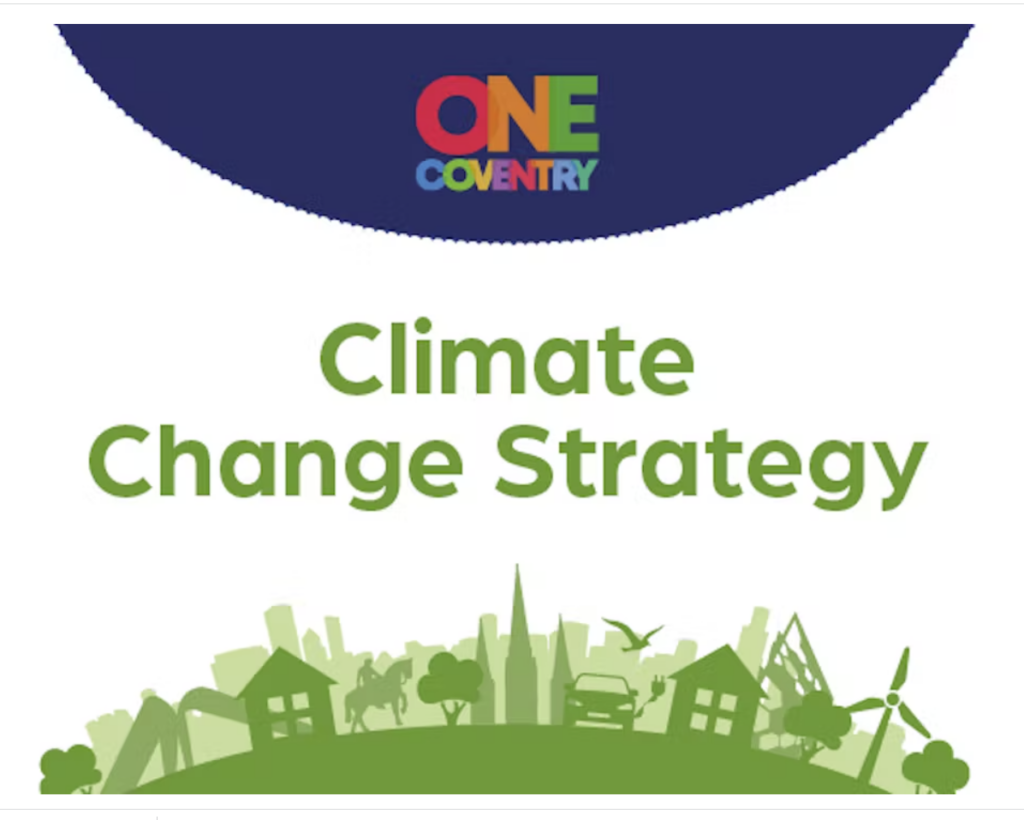
Further to our article about the consultation on Coventry’s Climate Change Strategy, Coventry Green New Deal have circulated their response to the strategy. David Ridley and Tom Maidment write…..
On Wednesday 15th February, Coventry City Council launched its new Climate Change Strategy, “A Green Future for a Changing City 2022 – 2030.” With the strategy many years late, what was presented didn’t meet expectations, although there were glimmers of hope which must be seized upon.
There is no question that the council is leading on some good individual projects, Very Light Rail for example. But after three years in the role, Bret Willers, the council’s Head of Sustainability and Climate Change, presented a disjointed list of projects happening in the city, shoehorned into the ICLEI sustainability framework, many of which are speculative and most of them community-led initiatives rather than by the council.
That is not a strategy. The draft “strategy” lacks any long-term vision and is entirely devoid of any coherent roadmap that harnesses the collective power of the Council to deliver a net zero city.
The one redeeming piece of work is Andy Gouldson’s “Net Zero Routemap For Coventry”, commissioned by the Council, but not published alongside the strategy. (We are currently waiting for it to be published). The Routemap does what the strategy fails to do: sets out a carbon reduction target required for the city to deliver its contribution to the UK’s 2050 Net Zero target and the technologies, policies and collaboration we need to get there.
Gouldson, who is professor of Environmental Policy at the University of Leeds, and co-founder of the ESRC Place-based Climate Action Network, which Coventry is now part of, recognized at the launch that Coventry has nearly halved its carbon footprint already since 1990. However, Gouldson also pointed out that this was “more by accident than by design” and almost entirely down to the nationwide installation of renewable energy and phase out of coal, international efforts to improve product efficiency and the historical deindustrialization of the city of Coventry. The remaining half is the hardest part, requiring a clear routemap that we can all sign up to and a concerted, collective effort to get us there.
We know that Gouldson’s report outlines three pathways that the city can take requiring the leadership of the council. The most ambitious would return £144m per year into people’s pockets through energy savings alone, create an additional 20,407 years’ worth of good, well-paid jobs in the city requiring a range of skillsets, and close the remaining gap to net zero by 59%. It is impossible to quantify all the secondary and tertiary effects such investment would have but it is very likely to more than pay back in the wider economy, not to mention how much cleaner air, warmer homes and more green space would enhance the lives of people across the city. The Council, however suggests it will choose instead paths of insufficient change, betting on “future innovations and advances in technology” to get it across the line.
Cllr O’Boyle, supported by the officers and elected members of the Council, should be engaging as many stakeholders as possible to deliver on this most ambitious pathway, but instead even many Cabinet Members report being shut out of the process. Willers and O’Boyle need to engage the expertise within the council and communities to understand how they can break down barriers big and small. Housing and Public Health could work together on green bonds that start a program of retrofit that would make homes warmer, engaging also with Education and Skills to ensure we upskill plumbers and gas fitters to install heat pumps, ensuring those trades are equipped for the green jobs of the future. They should continue working with central government to build more cycle lanes, but also with City Services to provide training on how to ride and maintain a bike, just as they do in Birmingham, and with Planning to ensure developments include secure and convenient bike storage.
Using Gouldson’s Routemap, the council has the opportunity to set out a clear vision for the city in the next decades; greener, healthier and more prosperous. We see how this has been done properly in other cities, like Edinburgh. Edinburgh City Council’s 2030 Climate Strategy makes clear that the most ambitious option presented by their own Gouldson-commissioned Routemap (pdf) is a necessary, and even then, not sufficient, condition of achieving its climate goals. To make up the remaining shortfall in emissions reduction, Edinburgh Council admits it must include “stretch” options like “large-scale tree planting, accelerated adoption of active travel, or the electrification of industrial heating and cooling.”
Gouldson’s report does the difficult, technical part of laying out how much we can emit over time, how this should translate to yearly targets, what interventions are required to achieve them and how much that is likely to cost. Weaving from that a vision and a strategy for implementation is not only possible, but the least we should expect from our elected representatives. That they continue to abdicate that responsibility will see our city lose jobs in the future, make us less attractive for businesses and stall our regeneration.
The non-strategy strategy the council presented was unquestionably a disappointment, but perhaps what was most disappointing is how it snatched failure from the jaws of success. Gouldson has given the council the roadmap, now they just need to find their way.
CovSoc members have the opportunity to attend a special consultation meeting about the Climate Change strategy next month and can form their own opinion about the strategy after hearing from its authors. CovSoc will prepare its own response to the strategy after that meeting.
